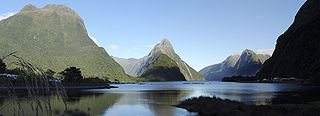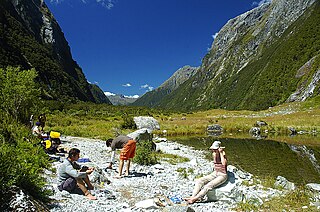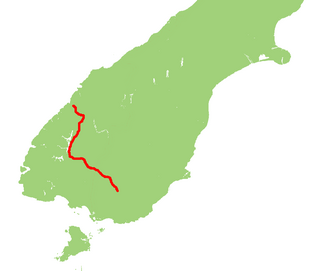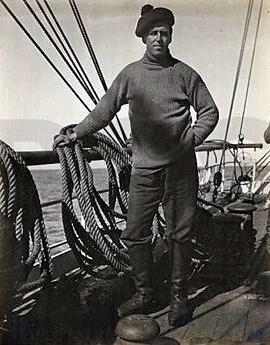
Milford Sound is a fiord in the south west of New Zealand's South Island within Fiordland National Park, Piopiotahi Marine Reserve, and the Te Wahipounamu World Heritage site. It has been judged the world's top travel destination in an international survey and is acclaimed as New Zealand's most famous tourist destination. Rudyard Kipling called it the eighth Wonder of the World. The fiord is most commonly accessed via road by tour coach, with the road terminating at a small village also called Milford Sound.

Fiordland, is a non-administrative geographical region of New Zealand in the south-western corner of the South Island, comprising the western third of Southland. Most of Fiordland is dominated by the steep sides of the snow-capped Southern Alps, deep lakes, and its steep, glacier-carved and now ocean-flooded western valleys. The name "Fiordland" derives from an alternate spelling of the Scandinavian word for steep glacial valleys, "fjord". The geographic area of Fiordland is dominated by, and roughly coterminous with, Fiordland National Park, New Zealand's largest national park.

Fiordland National Park is a national park in the south-west corner of South Island of New Zealand. It is the largest of the 13 national parks in New Zealand, with an area covering 12,607 km2 (4,868 sq mi), and a major part of the Te Wāhipounamu a UNESCO World Heritage Site established in 1990. The park is administered by the Department of Conservation. The southern ranges of the Southern Alps cover most of Fiordland National Park, combined with the deep glacier-carved valleys.

Te Wāhipounamu is a World Heritage Site in the south west corner of the South Island of New Zealand.

Lake Te Anau is in the southwestern corner of the South Island of New Zealand. The lake covers an area of 344 km2 (133 sq mi), making it the second-largest lake by surface area in New Zealand and the largest in the South Island. It is the second largest lake in Australasia by fresh water volume. The main body of the lake runs north-south, and is 65 km in length. Three large fiords form arms to the lake on its western flank: North Fiord, Middle Fiord and South Fiord. These are the only inland fiords that New Zealand has, the other 14 are out on the coast. Several small islands lie in the entrance to Middle Fiord, which forks partway along its length into northwest and southwest arms. The surface of the lake is at an altitude of 210 m. It has a maximum depth of 425 m, so much of its bed lies below sea level, with the deepest part of the lake being 215 metres below sea level.

Te Anau is a town in the Southland region of the South Island of New Zealand. In Māori, Te-Anau means the Place of the Swirling Waters. It is on the eastern shore of Lake Te Anau in Fiordland. Te Anau is 155 kilometres north of Invercargill and 171 kilometres to the southwest of Queenstown. Manapouri lies 21 kilometres to the south. Te Anau lies at the southern end of the Milford Road, 117 kilometres to the south of Milford Sound.

The Milford Track is a hiking route in New Zealand, located amidst mountains and temperate rain forest in Fiordland National Park in the southwest of the South Island. The 53.5 km (33.2 mi) hike starts at Glade Wharf at the head of Lake Te Anau and finishes in Milford Sound at Sandfly Point, traversing rainforests, wetlands, and an alpine pass.

State Highway 94 is a New Zealand state highway connecting the large Southland town of Gore with one of New Zealand's most popular destinations, Milford Sound. It also passes the significant townships of Lumsden and Te Anau as well going through the Homer Tunnel. The road also goes through Fiordland and crosses the Main Divide of the Southern Alps.

Omanui / McKinnon Pass is an alpine pass between Mount Hart and Mount Balloon in Fiordland, New Zealand. The pass is at an elevation of 1,154 metres (3,786 ft) and is located 19 kilometres (12 mi) southwest of Milford Sound / Piopiotahi. The pass is the highest point of the famous Milford Track connecting Lake Te Anau and the Clinton River valley with the Arthur River valley and Milford Sound / Piopiotahi.

Quintin McPherson McKinnon, (1851–1892) was a Scottish New Zealand explorer and tour guide.

The Haast-Hollyford road or Haast-Hollyford Highway is a long-standing proposal to link Haast via the Hollyford Valley to Milford Sound and Te Anau in the South Island of New Zealand. Proposals for this road have been mooted since the 1880s.

James Robert Dennistoun was a New Zealand mountaineer, explorer and airman in the First World War. He is known in particular as the first person to climb to the top of Mitre Peak / Rahotu.

Donald Sutherland was a Scottish-born New Zealand explorer, active in the late 19th century. Born in Wick, he served as a soldier in the Expedition of the Thousand, led by Giuseppe Garibaldi, in the Italian unification wars. Soon afterwards he travelled to New Zealand where he prospected for gold in Otago. He later joined the New Zealand military and fought in a number of engagements of the New Zealand Wars. In 1877, he settled in Milford Sound and lived as a hermit for a number of years, exploring the region. He later married and, with his wife, ran an accommodation facility for the increasing number of tourists visiting Milford Sound until his death in October 1919. The Sutherland Falls, located near Milford Sound and the highest waterfall in New Zealand, is named for him.

Mount Eglinton is an 1,854-metre-elevation (6,083-foot) mountain summit in the Fiordland Region of New Zealand.

Mount Pembroke is a 2,015-metre-elevation (6,611-foot) mountain in Fiordland, New Zealand.

Mount Talbot is a 2,105-metre-elevation (6,906-foot) mountain in Fiordland, New Zealand.

Pyramid Peak is a 2,295-metre-elevation (7,530-foot) mountain summit in the Fiordland Region of New Zealand.

Mount Elliot is a 1,990-metre-elevation (6,529-foot) mountain in Fiordland, New Zealand.

Alice Peak is a 2,155-metre-elevation (7,070-foot) mountain in Fiordland, New Zealand.
Mount Sparrman is a 969-metre-elevation (3,179-foot) hill in Fiordland, New Zealand. The hill is notable as the first peak in New Zealand climbed by Europeans; this happened in 1773 as part of the second voyage of James Cook.




















